Report on Contemporary Issues in People Management
VerifiedAdded on 2023/01/03
|10
|2423
|63
Report
AI Summary
This report delves into the critical aspects of people management, exploring contemporary challenges faced by line managers. It examines the significance of employee engagement, training, and development, emphasizing various learning theories and leadership models like contingency theory. The report highlights the importance of skills, knowledge, and behavior in effective people management, including team-building strategies and motivational theories such as Maslow's hierarchy of needs. Furthermore, it analyzes human resource processes that support effective performance management, such as performance management reviews and 360-degree feedback appraisal. The report concludes with recommendations for improving human resource practices, advocating for tailored training programs and appropriate performance appraisal techniques to enhance organizational outcomes. The report utilizes examples from Asda to illustrate these concepts.

Intro To PM
Paraphrase This Document
Need a fresh take? Get an instant paraphrase of this document with our AI Paraphraser
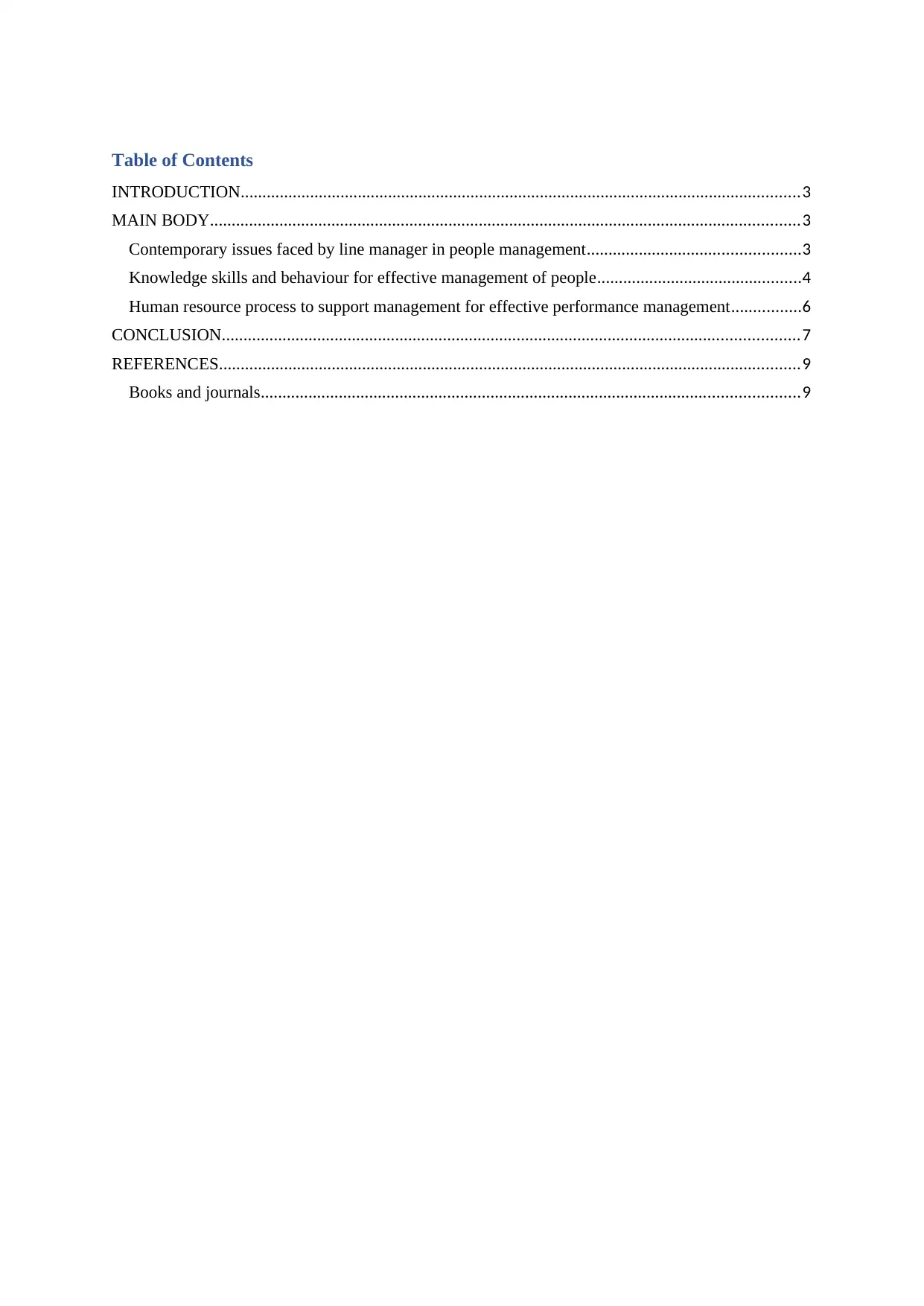
Table of Contents
INTRODUCTION.................................................................................................................................3
MAIN BODY........................................................................................................................................3
Contemporary issues faced by line manager in people management.................................................3
Knowledge skills and behaviour for effective management of people...............................................4
Human resource process to support management for effective performance management................6
CONCLUSION.....................................................................................................................................7
REFERENCES......................................................................................................................................9
Books and journals............................................................................................................................9
INTRODUCTION.................................................................................................................................3
MAIN BODY........................................................................................................................................3
Contemporary issues faced by line manager in people management.................................................3
Knowledge skills and behaviour for effective management of people...............................................4
Human resource process to support management for effective performance management................6
CONCLUSION.....................................................................................................................................7
REFERENCES......................................................................................................................................9
Books and journals............................................................................................................................9
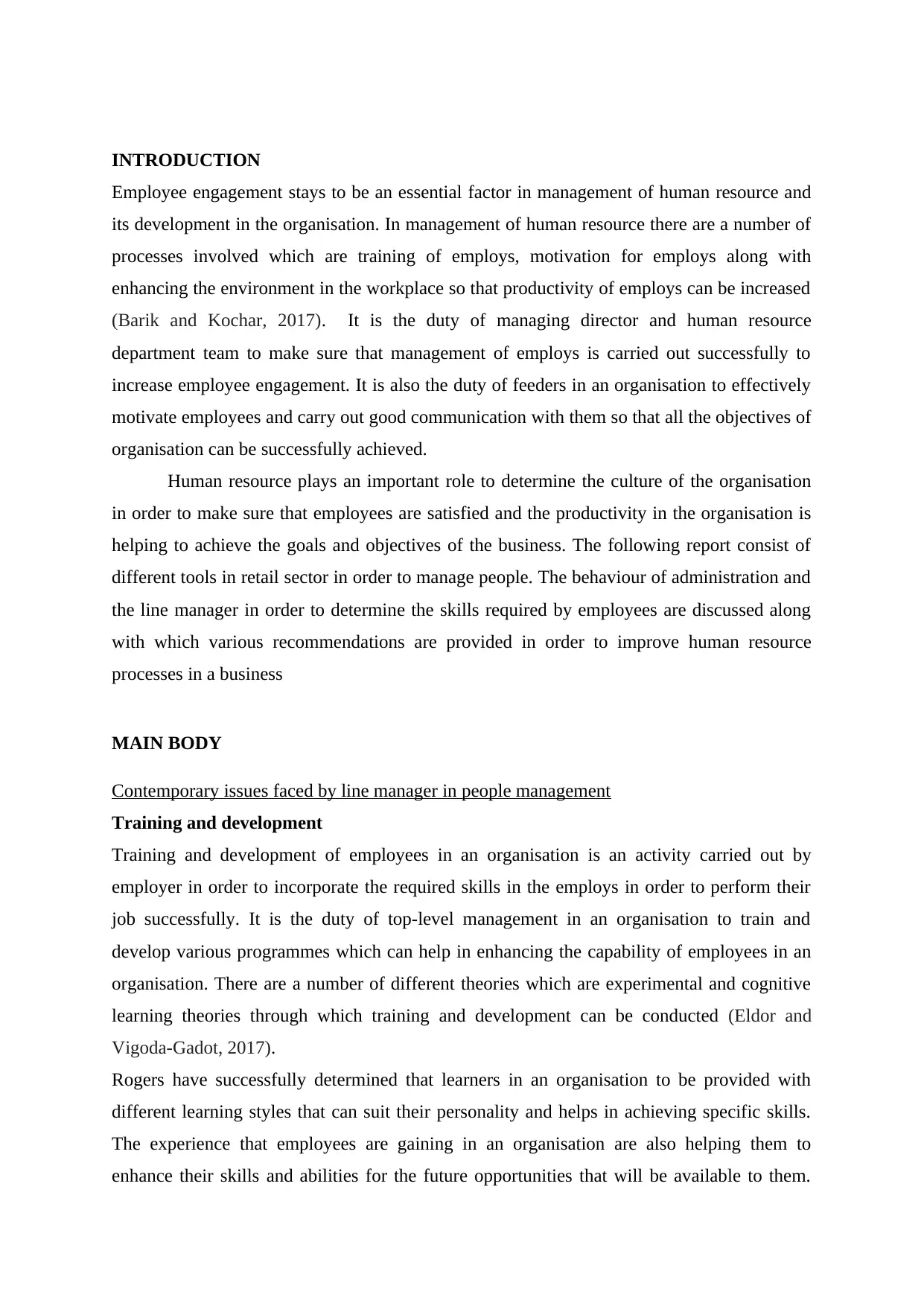
INTRODUCTION
Employee engagement stays to be an essential factor in management of human resource and
its development in the organisation. In management of human resource there are a number of
processes involved which are training of employs, motivation for employs along with
enhancing the environment in the workplace so that productivity of employs can be increased
(Barik and Kochar, 2017). It is the duty of managing director and human resource
department team to make sure that management of employs is carried out successfully to
increase employee engagement. It is also the duty of feeders in an organisation to effectively
motivate employees and carry out good communication with them so that all the objectives of
organisation can be successfully achieved.
Human resource plays an important role to determine the culture of the organisation
in order to make sure that employees are satisfied and the productivity in the organisation is
helping to achieve the goals and objectives of the business. The following report consist of
different tools in retail sector in order to manage people. The behaviour of administration and
the line manager in order to determine the skills required by employees are discussed along
with which various recommendations are provided in order to improve human resource
processes in a business
MAIN BODY
Contemporary issues faced by line manager in people management
Training and development
Training and development of employees in an organisation is an activity carried out by
employer in order to incorporate the required skills in the employs in order to perform their
job successfully. It is the duty of top-level management in an organisation to train and
develop various programmes which can help in enhancing the capability of employees in an
organisation. There are a number of different theories which are experimental and cognitive
learning theories through which training and development can be conducted (Eldor and
Vigoda-Gadot, 2017).
Rogers have successfully determined that learners in an organisation to be provided with
different learning styles that can suit their personality and helps in achieving specific skills.
The experience that employees are gaining in an organisation are also helping them to
enhance their skills and abilities for the future opportunities that will be available to them.
Employee engagement stays to be an essential factor in management of human resource and
its development in the organisation. In management of human resource there are a number of
processes involved which are training of employs, motivation for employs along with
enhancing the environment in the workplace so that productivity of employs can be increased
(Barik and Kochar, 2017). It is the duty of managing director and human resource
department team to make sure that management of employs is carried out successfully to
increase employee engagement. It is also the duty of feeders in an organisation to effectively
motivate employees and carry out good communication with them so that all the objectives of
organisation can be successfully achieved.
Human resource plays an important role to determine the culture of the organisation
in order to make sure that employees are satisfied and the productivity in the organisation is
helping to achieve the goals and objectives of the business. The following report consist of
different tools in retail sector in order to manage people. The behaviour of administration and
the line manager in order to determine the skills required by employees are discussed along
with which various recommendations are provided in order to improve human resource
processes in a business
MAIN BODY
Contemporary issues faced by line manager in people management
Training and development
Training and development of employees in an organisation is an activity carried out by
employer in order to incorporate the required skills in the employs in order to perform their
job successfully. It is the duty of top-level management in an organisation to train and
develop various programmes which can help in enhancing the capability of employees in an
organisation. There are a number of different theories which are experimental and cognitive
learning theories through which training and development can be conducted (Eldor and
Vigoda-Gadot, 2017).
Rogers have successfully determined that learners in an organisation to be provided with
different learning styles that can suit their personality and helps in achieving specific skills.
The experience that employees are gaining in an organisation are also helping them to
enhance their skills and abilities for the future opportunities that will be available to them.
⊘ This is a preview!⊘
Do you want full access?
Subscribe today to unlock all pages.

Trusted by 1+ million students worldwide
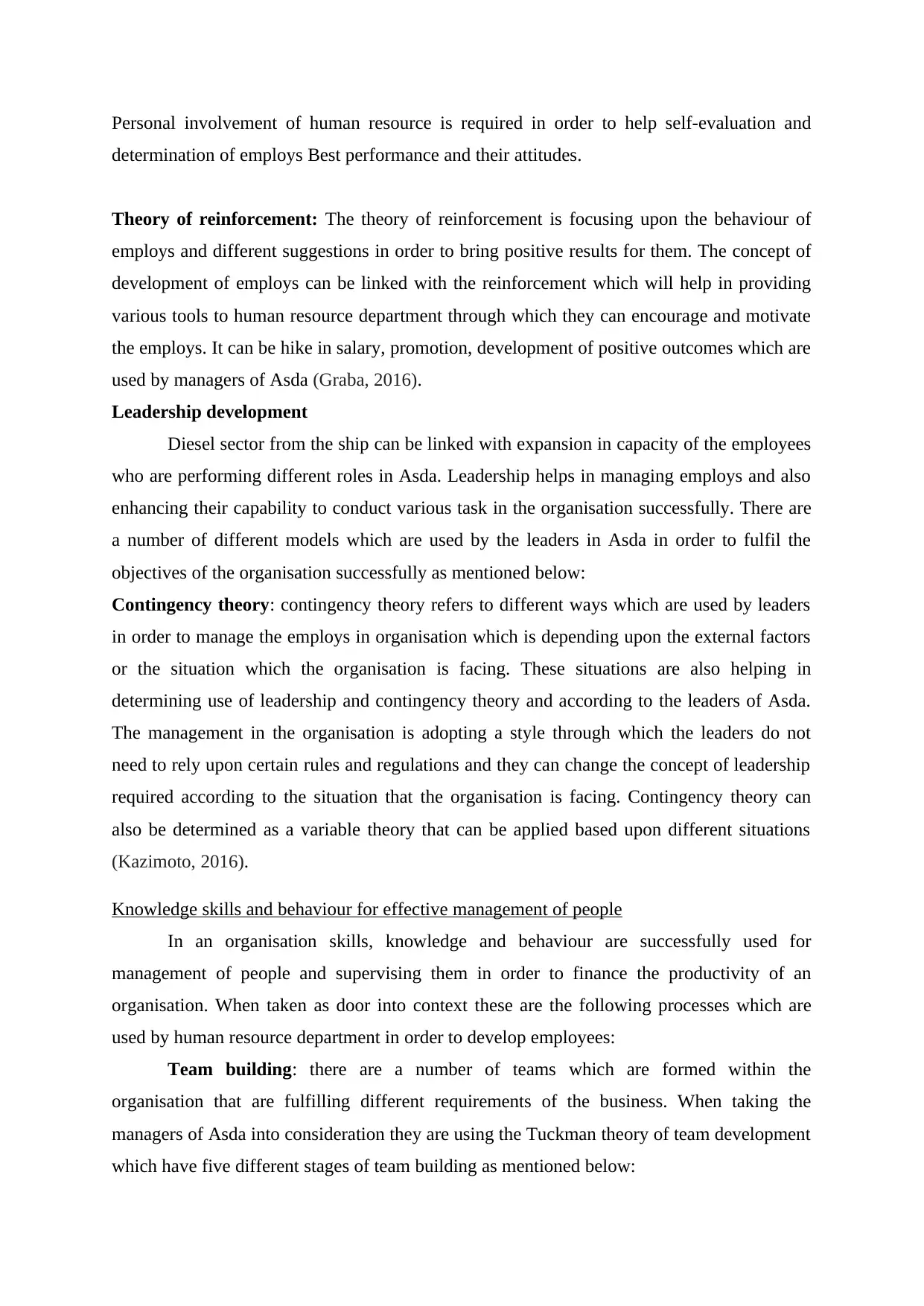
Personal involvement of human resource is required in order to help self-evaluation and
determination of employs Best performance and their attitudes.
Theory of reinforcement: The theory of reinforcement is focusing upon the behaviour of
employs and different suggestions in order to bring positive results for them. The concept of
development of employs can be linked with the reinforcement which will help in providing
various tools to human resource department through which they can encourage and motivate
the employs. It can be hike in salary, promotion, development of positive outcomes which are
used by managers of Asda (Graba, 2016).
Leadership development
Diesel sector from the ship can be linked with expansion in capacity of the employees
who are performing different roles in Asda. Leadership helps in managing employs and also
enhancing their capability to conduct various task in the organisation successfully. There are
a number of different models which are used by the leaders in Asda in order to fulfil the
objectives of the organisation successfully as mentioned below:
Contingency theory: contingency theory refers to different ways which are used by leaders
in order to manage the employs in organisation which is depending upon the external factors
or the situation which the organisation is facing. These situations are also helping in
determining use of leadership and contingency theory and according to the leaders of Asda.
The management in the organisation is adopting a style through which the leaders do not
need to rely upon certain rules and regulations and they can change the concept of leadership
required according to the situation that the organisation is facing. Contingency theory can
also be determined as a variable theory that can be applied based upon different situations
(Kazimoto, 2016).
Knowledge skills and behaviour for effective management of people
In an organisation skills, knowledge and behaviour are successfully used for
management of people and supervising them in order to finance the productivity of an
organisation. When taken as door into context these are the following processes which are
used by human resource department in order to develop employees:
Team building: there are a number of teams which are formed within the
organisation that are fulfilling different requirements of the business. When taking the
managers of Asda into consideration they are using the Tuckman theory of team development
which have five different stages of team building as mentioned below:
determination of employs Best performance and their attitudes.
Theory of reinforcement: The theory of reinforcement is focusing upon the behaviour of
employs and different suggestions in order to bring positive results for them. The concept of
development of employs can be linked with the reinforcement which will help in providing
various tools to human resource department through which they can encourage and motivate
the employs. It can be hike in salary, promotion, development of positive outcomes which are
used by managers of Asda (Graba, 2016).
Leadership development
Diesel sector from the ship can be linked with expansion in capacity of the employees
who are performing different roles in Asda. Leadership helps in managing employs and also
enhancing their capability to conduct various task in the organisation successfully. There are
a number of different models which are used by the leaders in Asda in order to fulfil the
objectives of the organisation successfully as mentioned below:
Contingency theory: contingency theory refers to different ways which are used by leaders
in order to manage the employs in organisation which is depending upon the external factors
or the situation which the organisation is facing. These situations are also helping in
determining use of leadership and contingency theory and according to the leaders of Asda.
The management in the organisation is adopting a style through which the leaders do not
need to rely upon certain rules and regulations and they can change the concept of leadership
required according to the situation that the organisation is facing. Contingency theory can
also be determined as a variable theory that can be applied based upon different situations
(Kazimoto, 2016).
Knowledge skills and behaviour for effective management of people
In an organisation skills, knowledge and behaviour are successfully used for
management of people and supervising them in order to finance the productivity of an
organisation. When taken as door into context these are the following processes which are
used by human resource department in order to develop employees:
Team building: there are a number of teams which are formed within the
organisation that are fulfilling different requirements of the business. When taking the
managers of Asda into consideration they are using the Tuckman theory of team development
which have five different stages of team building as mentioned below:
Paraphrase This Document
Need a fresh take? Get an instant paraphrase of this document with our AI Paraphraser
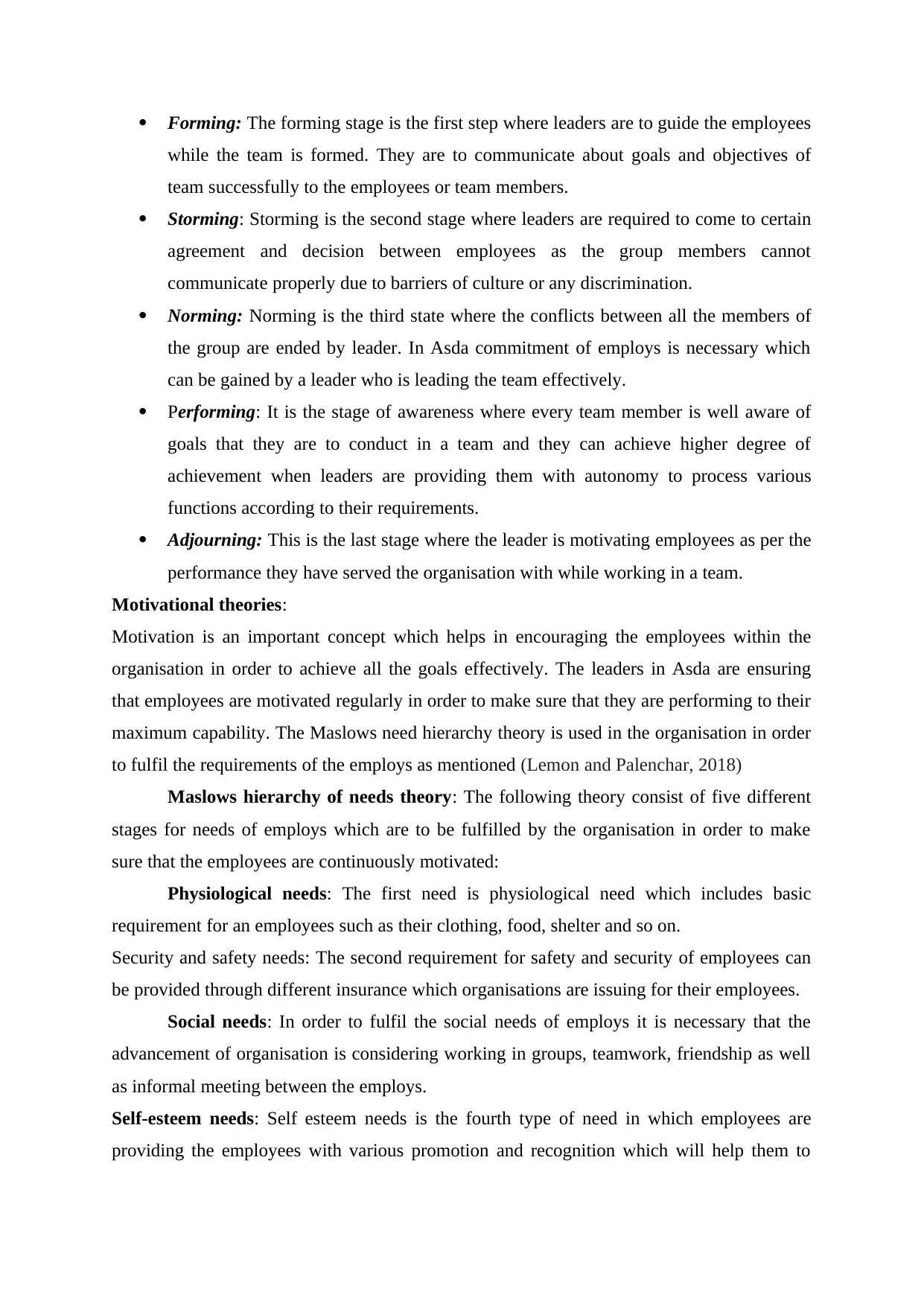
Forming: The forming stage is the first step where leaders are to guide the employees
while the team is formed. They are to communicate about goals and objectives of
team successfully to the employees or team members.
Storming: Storming is the second stage where leaders are required to come to certain
agreement and decision between employees as the group members cannot
communicate properly due to barriers of culture or any discrimination.
Norming: Norming is the third state where the conflicts between all the members of
the group are ended by leader. In Asda commitment of employs is necessary which
can be gained by a leader who is leading the team effectively.
Performing: It is the stage of awareness where every team member is well aware of
goals that they are to conduct in a team and they can achieve higher degree of
achievement when leaders are providing them with autonomy to process various
functions according to their requirements.
Adjourning: This is the last stage where the leader is motivating employees as per the
performance they have served the organisation with while working in a team.
Motivational theories:
Motivation is an important concept which helps in encouraging the employees within the
organisation in order to achieve all the goals effectively. The leaders in Asda are ensuring
that employees are motivated regularly in order to make sure that they are performing to their
maximum capability. The Maslows need hierarchy theory is used in the organisation in order
to fulfil the requirements of the employs as mentioned (Lemon and Palenchar, 2018)
Maslows hierarchy of needs theory: The following theory consist of five different
stages for needs of employs which are to be fulfilled by the organisation in order to make
sure that the employees are continuously motivated:
Physiological needs: The first need is physiological need which includes basic
requirement for an employees such as their clothing, food, shelter and so on.
Security and safety needs: The second requirement for safety and security of employees can
be provided through different insurance which organisations are issuing for their employees.
Social needs: In order to fulfil the social needs of employs it is necessary that the
advancement of organisation is considering working in groups, teamwork, friendship as well
as informal meeting between the employs.
Self-esteem needs: Self esteem needs is the fourth type of need in which employees are
providing the employees with various promotion and recognition which will help them to
while the team is formed. They are to communicate about goals and objectives of
team successfully to the employees or team members.
Storming: Storming is the second stage where leaders are required to come to certain
agreement and decision between employees as the group members cannot
communicate properly due to barriers of culture or any discrimination.
Norming: Norming is the third state where the conflicts between all the members of
the group are ended by leader. In Asda commitment of employs is necessary which
can be gained by a leader who is leading the team effectively.
Performing: It is the stage of awareness where every team member is well aware of
goals that they are to conduct in a team and they can achieve higher degree of
achievement when leaders are providing them with autonomy to process various
functions according to their requirements.
Adjourning: This is the last stage where the leader is motivating employees as per the
performance they have served the organisation with while working in a team.
Motivational theories:
Motivation is an important concept which helps in encouraging the employees within the
organisation in order to achieve all the goals effectively. The leaders in Asda are ensuring
that employees are motivated regularly in order to make sure that they are performing to their
maximum capability. The Maslows need hierarchy theory is used in the organisation in order
to fulfil the requirements of the employs as mentioned (Lemon and Palenchar, 2018)
Maslows hierarchy of needs theory: The following theory consist of five different
stages for needs of employs which are to be fulfilled by the organisation in order to make
sure that the employees are continuously motivated:
Physiological needs: The first need is physiological need which includes basic
requirement for an employees such as their clothing, food, shelter and so on.
Security and safety needs: The second requirement for safety and security of employees can
be provided through different insurance which organisations are issuing for their employees.
Social needs: In order to fulfil the social needs of employs it is necessary that the
advancement of organisation is considering working in groups, teamwork, friendship as well
as informal meeting between the employs.
Self-esteem needs: Self esteem needs is the fourth type of need in which employees are
providing the employees with various promotion and recognition which will help them to
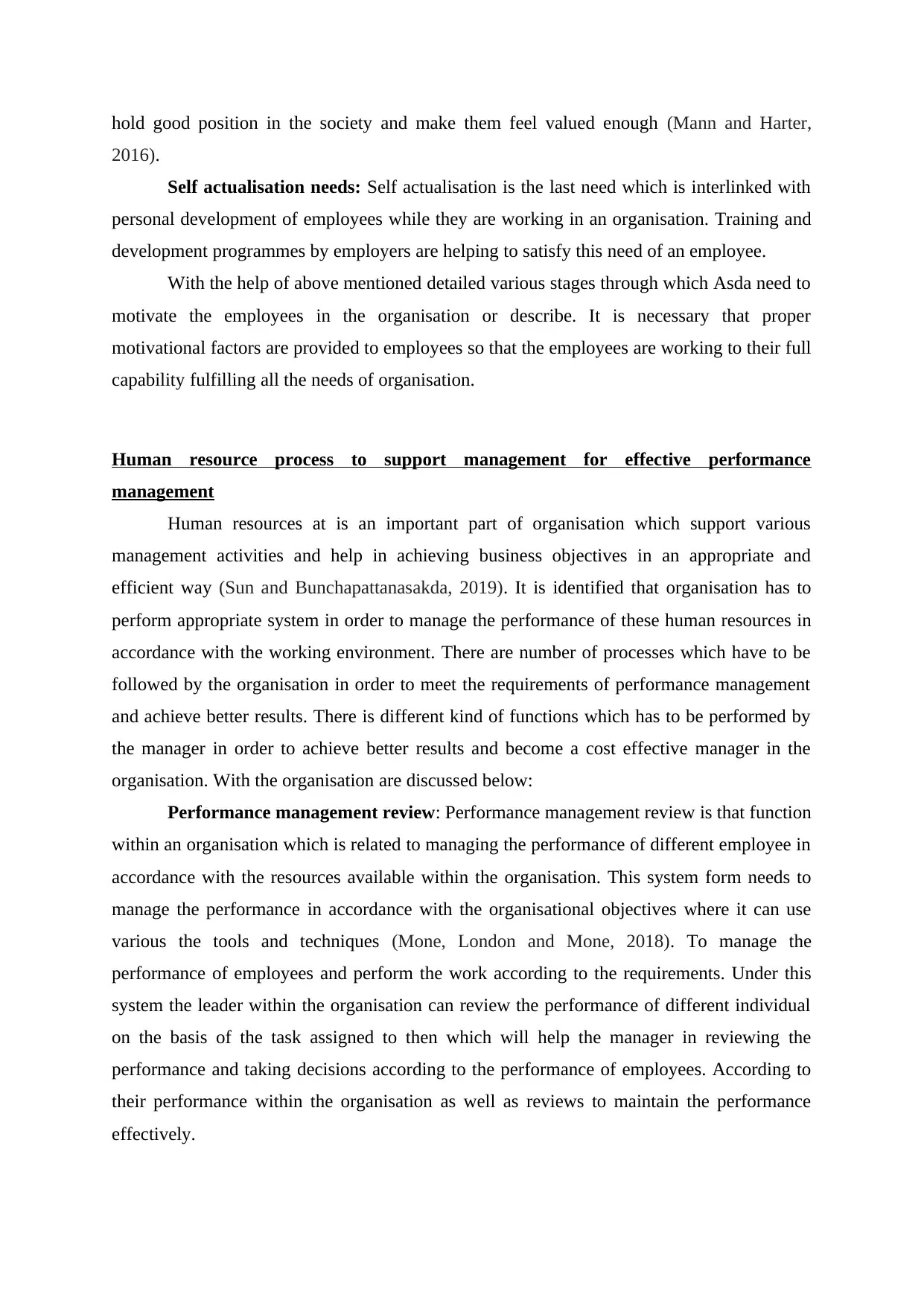
hold good position in the society and make them feel valued enough (Mann and Harter,
2016).
Self actualisation needs: Self actualisation is the last need which is interlinked with
personal development of employees while they are working in an organisation. Training and
development programmes by employers are helping to satisfy this need of an employee.
With the help of above mentioned detailed various stages through which Asda need to
motivate the employees in the organisation or describe. It is necessary that proper
motivational factors are provided to employees so that the employees are working to their full
capability fulfilling all the needs of organisation.
Human resource process to support management for effective performance
management
Human resources at is an important part of organisation which support various
management activities and help in achieving business objectives in an appropriate and
efficient way (Sun and Bunchapattanasakda, 2019). It is identified that organisation has to
perform appropriate system in order to manage the performance of these human resources in
accordance with the working environment. There are number of processes which have to be
followed by the organisation in order to meet the requirements of performance management
and achieve better results. There is different kind of functions which has to be performed by
the manager in order to achieve better results and become a cost effective manager in the
organisation. With the organisation are discussed below:
Performance management review: Performance management review is that function
within an organisation which is related to managing the performance of different employee in
accordance with the resources available within the organisation. This system form needs to
manage the performance in accordance with the organisational objectives where it can use
various the tools and techniques (Mone, London and Mone, 2018). To manage the
performance of employees and perform the work according to the requirements. Under this
system the leader within the organisation can review the performance of different individual
on the basis of the task assigned to then which will help the manager in reviewing the
performance and taking decisions according to the performance of employees. According to
their performance within the organisation as well as reviews to maintain the performance
effectively.
2016).
Self actualisation needs: Self actualisation is the last need which is interlinked with
personal development of employees while they are working in an organisation. Training and
development programmes by employers are helping to satisfy this need of an employee.
With the help of above mentioned detailed various stages through which Asda need to
motivate the employees in the organisation or describe. It is necessary that proper
motivational factors are provided to employees so that the employees are working to their full
capability fulfilling all the needs of organisation.
Human resource process to support management for effective performance
management
Human resources at is an important part of organisation which support various
management activities and help in achieving business objectives in an appropriate and
efficient way (Sun and Bunchapattanasakda, 2019). It is identified that organisation has to
perform appropriate system in order to manage the performance of these human resources in
accordance with the working environment. There are number of processes which have to be
followed by the organisation in order to meet the requirements of performance management
and achieve better results. There is different kind of functions which has to be performed by
the manager in order to achieve better results and become a cost effective manager in the
organisation. With the organisation are discussed below:
Performance management review: Performance management review is that function
within an organisation which is related to managing the performance of different employee in
accordance with the resources available within the organisation. This system form needs to
manage the performance in accordance with the organisational objectives where it can use
various the tools and techniques (Mone, London and Mone, 2018). To manage the
performance of employees and perform the work according to the requirements. Under this
system the leader within the organisation can review the performance of different individual
on the basis of the task assigned to then which will help the manager in reviewing the
performance and taking decisions according to the performance of employees. According to
their performance within the organisation as well as reviews to maintain the performance
effectively.
⊘ This is a preview!⊘
Do you want full access?
Subscribe today to unlock all pages.

Trusted by 1+ million students worldwide
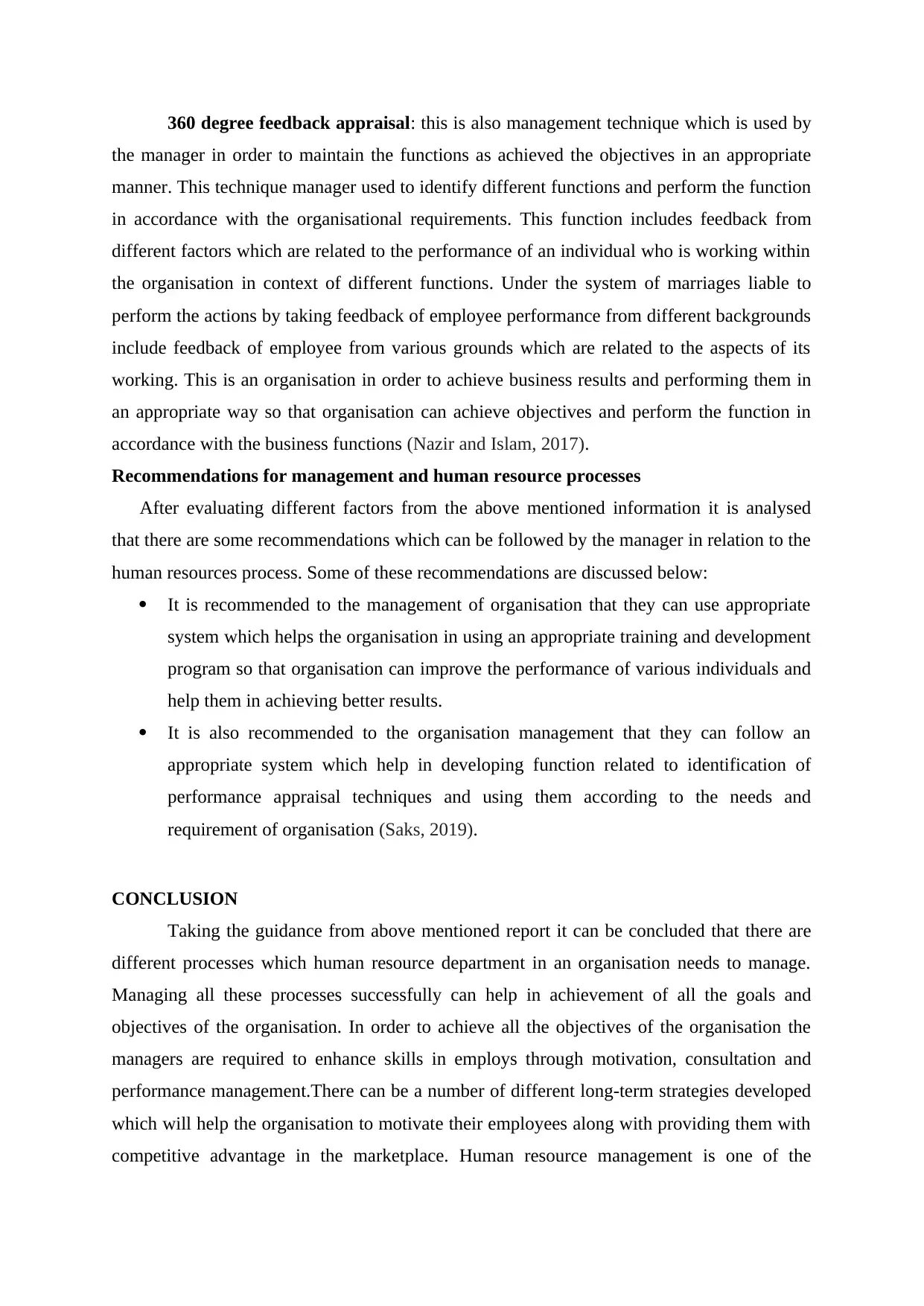
360 degree feedback appraisal: this is also management technique which is used by
the manager in order to maintain the functions as achieved the objectives in an appropriate
manner. This technique manager used to identify different functions and perform the function
in accordance with the organisational requirements. This function includes feedback from
different factors which are related to the performance of an individual who is working within
the organisation in context of different functions. Under the system of marriages liable to
perform the actions by taking feedback of employee performance from different backgrounds
include feedback of employee from various grounds which are related to the aspects of its
working. This is an organisation in order to achieve business results and performing them in
an appropriate way so that organisation can achieve objectives and perform the function in
accordance with the business functions (Nazir and Islam, 2017).
Recommendations for management and human resource processes
After evaluating different factors from the above mentioned information it is analysed
that there are some recommendations which can be followed by the manager in relation to the
human resources process. Some of these recommendations are discussed below:
It is recommended to the management of organisation that they can use appropriate
system which helps the organisation in using an appropriate training and development
program so that organisation can improve the performance of various individuals and
help them in achieving better results.
It is also recommended to the organisation management that they can follow an
appropriate system which help in developing function related to identification of
performance appraisal techniques and using them according to the needs and
requirement of organisation (Saks, 2019).
CONCLUSION
Taking the guidance from above mentioned report it can be concluded that there are
different processes which human resource department in an organisation needs to manage.
Managing all these processes successfully can help in achievement of all the goals and
objectives of the organisation. In order to achieve all the objectives of the organisation the
managers are required to enhance skills in employs through motivation, consultation and
performance management.There can be a number of different long-term strategies developed
which will help the organisation to motivate their employees along with providing them with
competitive advantage in the marketplace. Human resource management is one of the
the manager in order to maintain the functions as achieved the objectives in an appropriate
manner. This technique manager used to identify different functions and perform the function
in accordance with the organisational requirements. This function includes feedback from
different factors which are related to the performance of an individual who is working within
the organisation in context of different functions. Under the system of marriages liable to
perform the actions by taking feedback of employee performance from different backgrounds
include feedback of employee from various grounds which are related to the aspects of its
working. This is an organisation in order to achieve business results and performing them in
an appropriate way so that organisation can achieve objectives and perform the function in
accordance with the business functions (Nazir and Islam, 2017).
Recommendations for management and human resource processes
After evaluating different factors from the above mentioned information it is analysed
that there are some recommendations which can be followed by the manager in relation to the
human resources process. Some of these recommendations are discussed below:
It is recommended to the management of organisation that they can use appropriate
system which helps the organisation in using an appropriate training and development
program so that organisation can improve the performance of various individuals and
help them in achieving better results.
It is also recommended to the organisation management that they can follow an
appropriate system which help in developing function related to identification of
performance appraisal techniques and using them according to the needs and
requirement of organisation (Saks, 2019).
CONCLUSION
Taking the guidance from above mentioned report it can be concluded that there are
different processes which human resource department in an organisation needs to manage.
Managing all these processes successfully can help in achievement of all the goals and
objectives of the organisation. In order to achieve all the objectives of the organisation the
managers are required to enhance skills in employs through motivation, consultation and
performance management.There can be a number of different long-term strategies developed
which will help the organisation to motivate their employees along with providing them with
competitive advantage in the marketplace. Human resource management is one of the
Paraphrase This Document
Need a fresh take? Get an instant paraphrase of this document with our AI Paraphraser
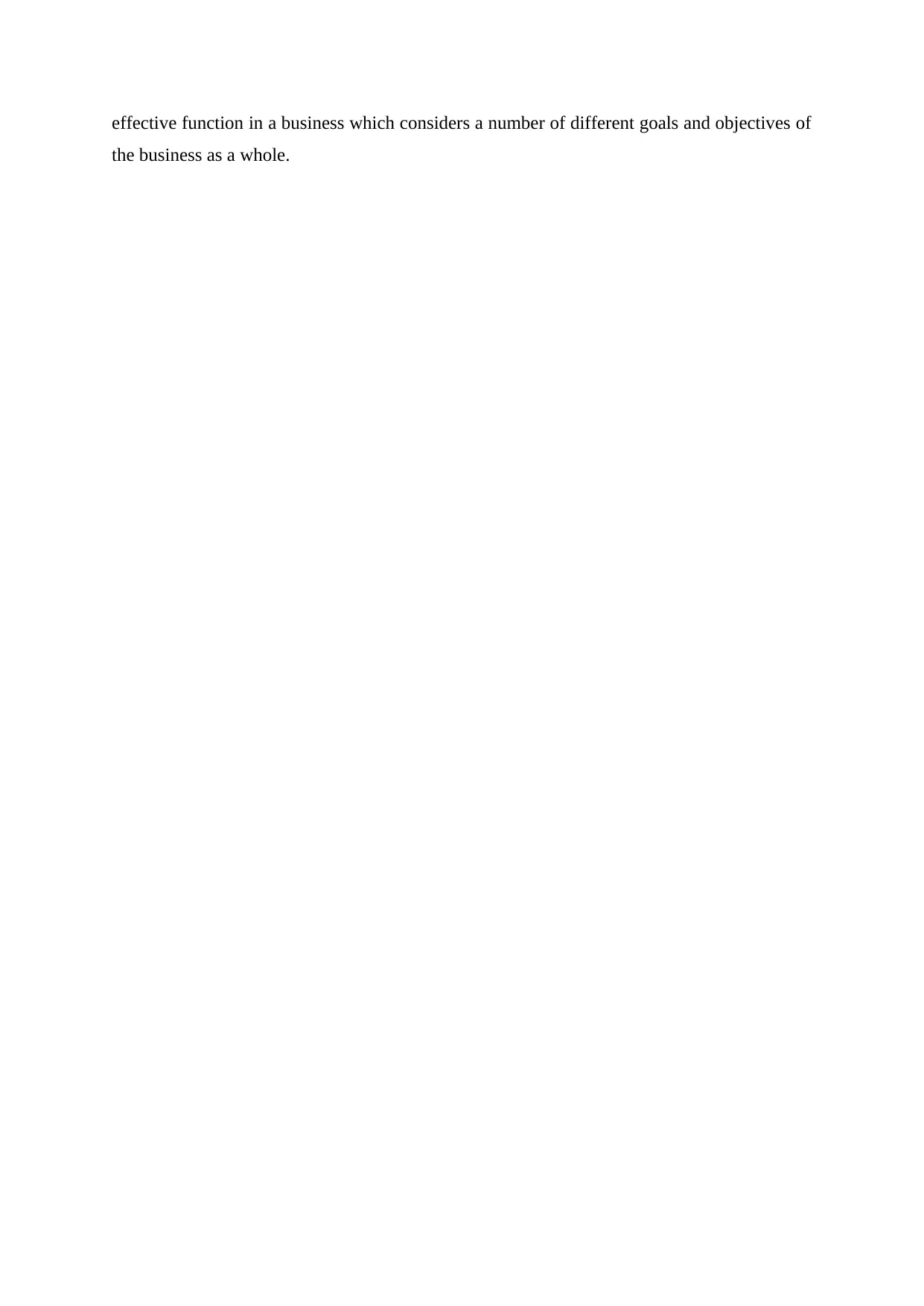
effective function in a business which considers a number of different goals and objectives of
the business as a whole.
the business as a whole.
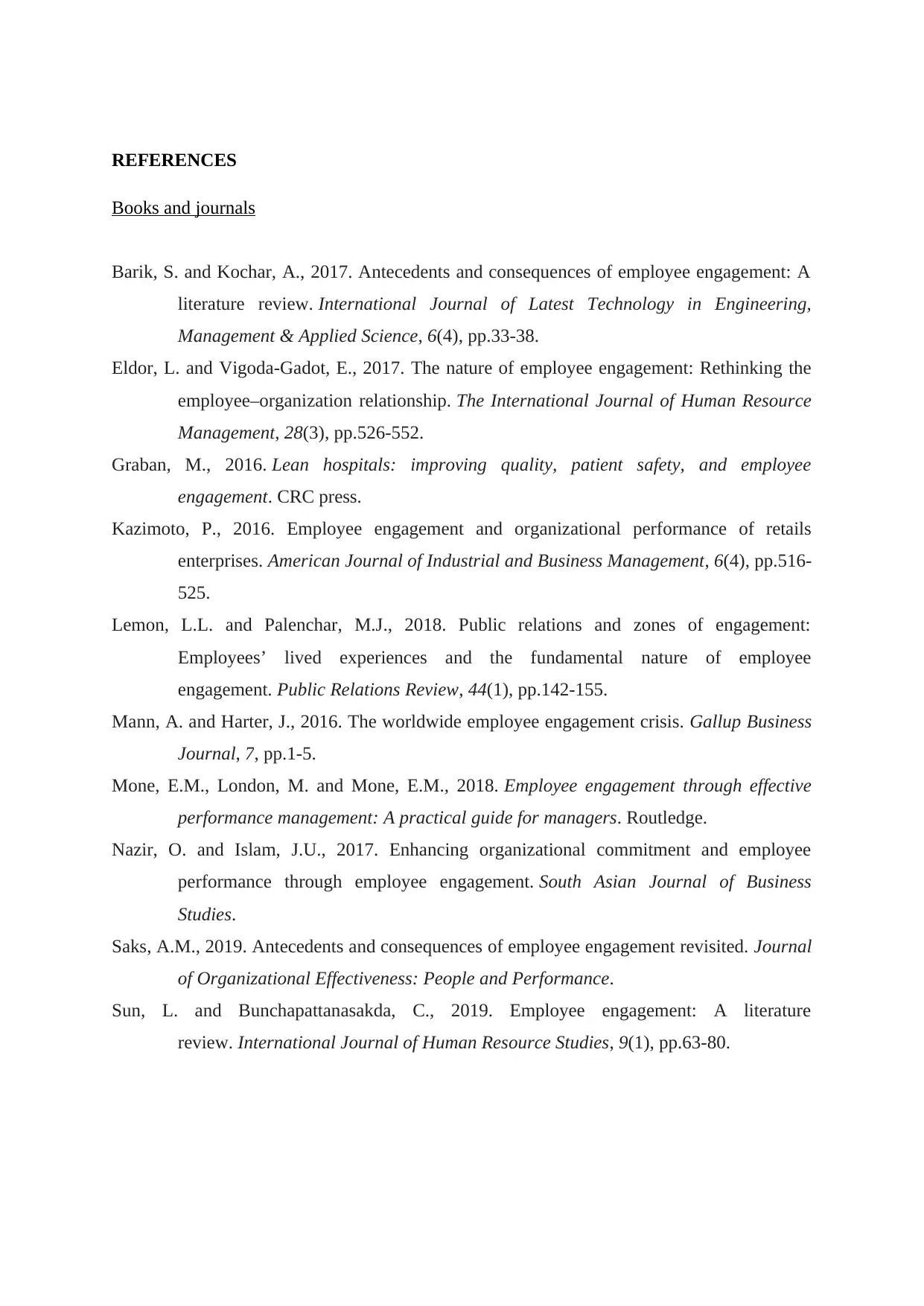
REFERENCES
Books and journals
Barik, S. and Kochar, A., 2017. Antecedents and consequences of employee engagement: A
literature review. International Journal of Latest Technology in Engineering,
Management & Applied Science, 6(4), pp.33-38.
Eldor, L. and Vigoda-Gadot, E., 2017. The nature of employee engagement: Rethinking the
employee–organization relationship. The International Journal of Human Resource
Management, 28(3), pp.526-552.
Graban, M., 2016. Lean hospitals: improving quality, patient safety, and employee
engagement. CRC press.
Kazimoto, P., 2016. Employee engagement and organizational performance of retails
enterprises. American Journal of Industrial and Business Management, 6(4), pp.516-
525.
Lemon, L.L. and Palenchar, M.J., 2018. Public relations and zones of engagement:
Employees’ lived experiences and the fundamental nature of employee
engagement. Public Relations Review, 44(1), pp.142-155.
Mann, A. and Harter, J., 2016. The worldwide employee engagement crisis. Gallup Business
Journal, 7, pp.1-5.
Mone, E.M., London, M. and Mone, E.M., 2018. Employee engagement through effective
performance management: A practical guide for managers. Routledge.
Nazir, O. and Islam, J.U., 2017. Enhancing organizational commitment and employee
performance through employee engagement. South Asian Journal of Business
Studies.
Saks, A.M., 2019. Antecedents and consequences of employee engagement revisited. Journal
of Organizational Effectiveness: People and Performance.
Sun, L. and Bunchapattanasakda, C., 2019. Employee engagement: A literature
review. International Journal of Human Resource Studies, 9(1), pp.63-80.
Books and journals
Barik, S. and Kochar, A., 2017. Antecedents and consequences of employee engagement: A
literature review. International Journal of Latest Technology in Engineering,
Management & Applied Science, 6(4), pp.33-38.
Eldor, L. and Vigoda-Gadot, E., 2017. The nature of employee engagement: Rethinking the
employee–organization relationship. The International Journal of Human Resource
Management, 28(3), pp.526-552.
Graban, M., 2016. Lean hospitals: improving quality, patient safety, and employee
engagement. CRC press.
Kazimoto, P., 2016. Employee engagement and organizational performance of retails
enterprises. American Journal of Industrial and Business Management, 6(4), pp.516-
525.
Lemon, L.L. and Palenchar, M.J., 2018. Public relations and zones of engagement:
Employees’ lived experiences and the fundamental nature of employee
engagement. Public Relations Review, 44(1), pp.142-155.
Mann, A. and Harter, J., 2016. The worldwide employee engagement crisis. Gallup Business
Journal, 7, pp.1-5.
Mone, E.M., London, M. and Mone, E.M., 2018. Employee engagement through effective
performance management: A practical guide for managers. Routledge.
Nazir, O. and Islam, J.U., 2017. Enhancing organizational commitment and employee
performance through employee engagement. South Asian Journal of Business
Studies.
Saks, A.M., 2019. Antecedents and consequences of employee engagement revisited. Journal
of Organizational Effectiveness: People and Performance.
Sun, L. and Bunchapattanasakda, C., 2019. Employee engagement: A literature
review. International Journal of Human Resource Studies, 9(1), pp.63-80.
⊘ This is a preview!⊘
Do you want full access?
Subscribe today to unlock all pages.

Trusted by 1+ million students worldwide

1 out of 10
Related Documents
Your All-in-One AI-Powered Toolkit for Academic Success.
+13062052269
info@desklib.com
Available 24*7 on WhatsApp / Email
![[object Object]](/_next/static/media/star-bottom.7253800d.svg)
Unlock your academic potential
Copyright © 2020–2025 A2Z Services. All Rights Reserved. Developed and managed by ZUCOL.





